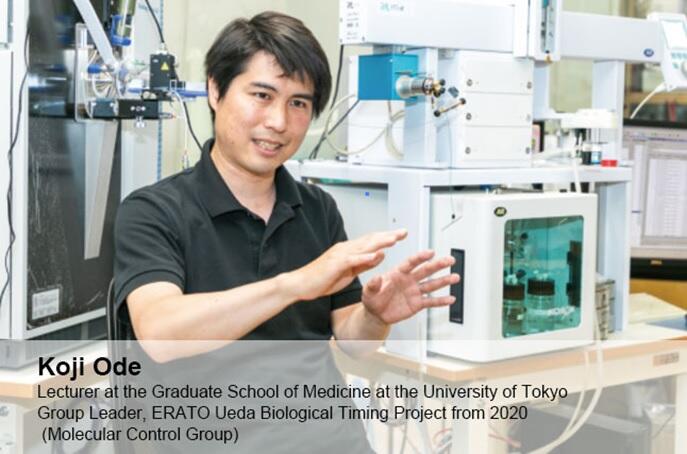Interest in sleep research has increased in recent years. The ERATO 'Ueda Biological Timing Project,' launched in October 2020, involves three sleep-research groups as well as the 'Children Sleep Checkup Project,' which analyzes and proposes guidelines for healthy sleep in children. JST News interviewed four individuals about the current state and future prospects of sleep research: Professor Hiroki Ueda of the Graduate School of Medicine at the University of Tokyo, who oversees the research (Research Director of the Project), Visiting Researcher Rikuhiro Yamada at the RIKEN Center for Biosystems Dynamics Research (RIKEN BDR), and Lecturer Koji L. Ode and Project Lecturer Akifumi Kishi of the Graduate School of Medicine at the University of Tokyo.
The switch that controls sleep — Investigations involving the chemical reactions of molecules in the body

Focusing on 'phosphorylation reactions': Analysis in collaboration with the Animal Analysis Group
All organisms sleep, but the duration and types of sleep differ among species. Furthermore, unlike other rhythms, such as the heartbeat, sleep and wakefulness can be temporarily adjusted in a flexible manner in response to work or study requirements. "Therefore, sleep is a very important phenomenon. Its inherent flexibility is both mysterious and interesting," explained Lecturer Koji Ode of the Graduate School of Medicine at the University of Tokyo.
Ode first became interested in molecular reactions in the body when he was a graduate student. "Molecules exhibit periods of activation (switch on) and deactivation (switch off) within cells, leading to complex reactions when the switch is activated at the right moment. To answer the question of how such complex responses can emerge from seemingly simple molecular reactions, I began researching the body's internal clock under the guidance of a post-doctoral researcher." While diligently working on his research, Ode was recommended by Ueda to lead the Molecular Control Group in 2020, where he became involved in sleep research.
As their name suggests, the Group's challenge is to discover the molecular reactions that switch between sleep and wakefulness. The group adopts the viewpoint that within the distinctive on/off phenomenon in an individual, molecular behaviors that directly reflect this phenomenon may exist. To this end, Ode focused on 'phosphorylation,' which is one of the best-studied biochemical reactions involving proteins.
The Molecular Control Group has analyzed mice expressing genetically modified phosphorylation sites, in collaboration with the Animal Analysis Group, to determine how sleep patterns in mice change when a specific protein is phosphorylated. The results revealed the existence of phosphorylation sites that induce sleep in the sequences of 'falling asleep' and 'remaining asleep' (see Figure). The link between protein states and the condition of the mouse transcends the boundaries of research fields, revealing insights that could not be explained from studies of 'molecules' or 'individuals' alone.
Figure: Sleep control model based on the phosphorylation state of the protein kinase CaMKIIβ

Wearing a wristwatch-type device — Sleep determining algorithm as the forefront of global technology
In collaboration with the Human Sleep Measurement Group, the Molecular Control Group is also developing the 'ACCEL' method (a high-precision machine-learning algorithm). By using the algorithm on acceleration data measured by a wristwatch-type device, it becomes possible to distinguish between periods of sleep and wakefulness. This algorithm, designed to determine sleep based solely on wrist acceleration, is considered to be at the forefront of global technology. Participants wear this device while staying over in the research facility so that sleep-related data can be collected. Ode has dedicated significant efforts to ensure that stable measurements are realized, not only in terms of numerical data, but also in how researchers explain use of the device to the participants and to ensure their comfort while wearing it.
"What is both interesting and challenging about sleep science research is that it goes beyond basic science, connecting with society in a manner that is easily understood by the general public," said Ode. In the future, he expects that it will become possible to discuss healthy and unhealthy sleep conditions from a physicochemical molecular perspective. He hopes that this will clarify guidelines for maintaining a healthy lifestyle. "While it is easy to tell children to go to bed early, which is somewhat vague, the root of this issue also lies in the societal lifestyle as a whole. Once the scientific principles are well-established, it should be possible to promote better sleep by encouraging people to change their societal lifestyle," he explained.
The challenge for the future is to reveal the phenomenon in terms of molecular activity, that is, to define why sleep and wakefulness are cyclical in nature, and furthermore, why these cycles autonomously repeat themselves. "The role of a researcher involves taking on concepts proposed by people in the past, and in this way, you are aware that you are becoming part of human history. In my case, there was no specific moment when I recognized myself as a researcher starting today. I was simply pursuing what I thought was interesting, and before I knew it, I had reached this point. I consider it a happy life," he said with a smile on his face. With Ode's research, a society in which people sleep better might just become a reality.
(Article: Naoko Yoshimoto, Photography: Seiko Kusu)




